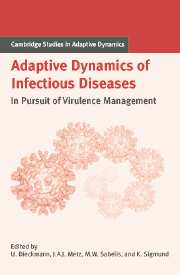Book contents
- Frontmatter
- Contents
- Contributing Authors
- List of Boxes
- Notational Standards
- 1 Introduction
- A Setting the Stage
- B Host Population Structure
- C Within-Host Interactions
- D Pathogen–Host Coevolution
- E Multilevel Selection
- F Vaccines and Drugs
- G Perspectives for Virulence Management
- Introduction to Part G
- 27 Taking Stock: Relating Theory to Experiment
- 28 Virulence Management in Humans
- 29 Virulence Management in Wildlife Populations
- 30 Virulence Management in Veterinary Epidemiology
- 31 Virulence Management in Plant–Pathogen Interactions
- 32 Virulence Management in Biocontrol Agents
- 33 Epilogue
- References
- Index
- International Institute for Applied Systems Analysis
32 - Virulence Management in Biocontrol Agents
Published online by Cambridge University Press: 15 January 2010
- Frontmatter
- Contents
- Contributing Authors
- List of Boxes
- Notational Standards
- 1 Introduction
- A Setting the Stage
- B Host Population Structure
- C Within-Host Interactions
- D Pathogen–Host Coevolution
- E Multilevel Selection
- F Vaccines and Drugs
- G Perspectives for Virulence Management
- Introduction to Part G
- 27 Taking Stock: Relating Theory to Experiment
- 28 Virulence Management in Humans
- 29 Virulence Management in Wildlife Populations
- 30 Virulence Management in Veterinary Epidemiology
- 31 Virulence Management in Plant–Pathogen Interactions
- 32 Virulence Management in Biocontrol Agents
- 33 Epilogue
- References
- Index
- International Institute for Applied Systems Analysis
Summary
Introduction
Although biological control is founded upon the virulence of natural enemies to the targeted pests, there has been little effort to understand how this might change, let alone to manage it. Frank Fenner and colleagues can be credited with being the first (and last!) to monitor changes in virulence of a biological control agent, namely the myxoma virus used to control rabbits in Australia (Fenner and Fantini 1999). This is despite a body of literature showing that the virulence of natural enemies can and does change in response to selective forces, either natural or artificial. These studies cover a wide taxonomic range of organisms, including fungal pathogens of plants (Burdon and Thrall 1999; Brasier et al. 1999; see also Chapter 31), microsporidian parasites of daphnids (Ebert 1994), pathogens and parasites of humans (Ewald 1994; Chapters 2 and 28), malarial parasites of rodents (Chapter 12), pathogens and parasites of social Hymenoptera (Schmid-Hempel 1998; Boot et al. 1999; Oldroyd 1999), nematode parasites of fig wasps and fruit flies (Herre 1993, 1995; Jaenike 1996, 1998), and hymenopteran parasitoids of aphids (Henter 1995; Henter and Via 1995). The results of this work have suggested that the course of virulence change can be predicted and possibly even manipulated. In biocontrol, a predator, parasitoid, or pathogen is used to control a pest population, a pest being defined as an animal, plant, or microorganism that is perceived to be damaging to some human activity.
- Type
- Chapter
- Information
- Adaptive Dynamics of Infectious DiseasesIn Pursuit of Virulence Management, pp. 448 - 459Publisher: Cambridge University PressPrint publication year: 2002
- 6
- Cited by

